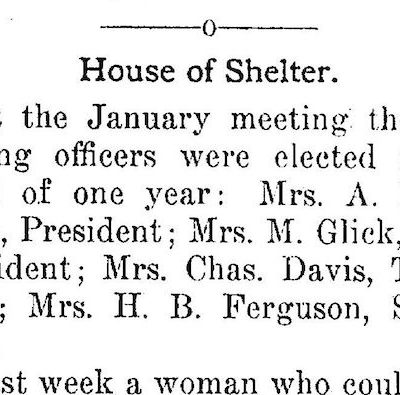
The House of Shelter provided short-term living accommodations for Jewish immigrants and others in Pittsburgh. The Hebrew Benevolent Society developed a forerunner to the House of Shelter as early as 1883 under the name Refuge of Strangers,[1]“Allegheny, Pa.,” American Israelite, Feb. 2, 1883, p261-262 (online—part 1, part 2—Newspapers.com). but the organization gained greater stability and permanence around 1903 with the help of Rabbi Aaron Mordechai Ashinsky and the oversight of a group of Jewish women.
The House of Shelter was initially located in several rented rooms associated with a small religious school on Our Way in the Hill District. The organization subsequently rented a five-room house on Chestnut Street and hired a married couple to oversee the operation and provide meals for residents. The House of Shelter later moved to a rented building at Stevenson and Gibbon streets.[2]“Wandering Jew is Sheltered,” Pittsburgh Post, Jan. 15, 1905, p6 (online—Newspapers.com). In October 1906, the House of Shelter purchased a building at 1625 Locust Street, where it stayed for the remainder of its existence. The building had 14 beds for clients, as well as a kitchen, a dining room, a reading room, a bathroom and a laundry room. Residents were allowed to stay for three days, with the stay extended in certain extreme cases.[3]“New House of Shelter Secured,” Pittsburgh Gazette-Times, Sept. 19, 1906, p7 (online—Newspapers.com).
In a 1910 overview, House of Shelter Secretary Mrs. H. B. Ferguson described six types of people who used the facility: recent immigrants who had been unable to find employment, the “sick and disabled,” families who had exhausted their funds while passing through Pittsburgh, women searching for missing husbands, “the pious Jew, who makes a living by selling wares of a religious nature,” and “the professional tramp.”[4]Ferguson, Mrs. H. B. “The Homeless Jew,” Jewish Criterion, Sept. 23, 1910, p. 21-22 (online).
The House of Shelter was integrated into a system of Jewish philanthropy in the Hill District in the early 20th century. It arranged a referral system with Beth Hamedrash Hagodol, which was the largest and most centrally located synagogue in the Hill District and therefore often the first place many Jewish immigrants visited upon arriving in Pittsburgh. The House of Shelter hosted the second organizational meeting for the Hebrew Ladies Hospital Aid Society and regularly referred residents to Montefiore Hospital. (It also maintained a network of local physicians who could provide preliminary medical care.) The House of Shelter established arrangements with hotels throughout the Hill District to accommodate overflow on the frequent occasions when the house was operating at capacity. It received basic goods from Jewish merchants, grocers, and bakers throughout the Hill District.
The House of Shelter became one of the initial beneficiaries of the Federation of the Jewish Philanthropies of Pittsburgh in 1912. The need for a House of Shelter in the Hill District began to wane in the late 1920’s, as federal immigration quotas led to a decline in Jewish immigration to the region and as the local Jewish population migrated to eastern neighborhoods of the city. By the early 1930s, the House of Shelter primarily served young American-born Jewish men who were passing through Pittsburgh in search of employment.
The House of Shelter sold its Locust Street building around 1943[5]One of the last mentions of the location is a notice of an annual House of Shelter meeting in the Jewish Criterion, Jan. 8, 1943, p 20 (online—Pittsburgh Jewish Newspaper Project). but continued providing temporary housing by other means through the 1950s. The House of Shelter liquidated its assets in 1968 and created the House of Shelter Fund at the United Jewish Federation to provide housing assistance.[6]United Jewish Federation board of directors minutes, April 23, 1968. United Jewish Federation Records [MSS 286], Rauh Jewish Archives at the Heinz History Center. The United Jewish Federation closed the fund in 1974 and transferred the assets to general use.[7]United Jewish Federation board of directors minutes, Sept. 10 and 24, 1974. United Jewish Federation Records [MSS 286], Rauh Jewish Archives at the Heinz History Center.
References
| ↑1 | “Allegheny, Pa.,” American Israelite, Feb. 2, 1883, p261-262 (online—part 1, part 2—Newspapers.com). |
|---|---|
| ↑2 | “Wandering Jew is Sheltered,” Pittsburgh Post, Jan. 15, 1905, p6 (online—Newspapers.com). |
| ↑3 | “New House of Shelter Secured,” Pittsburgh Gazette-Times, Sept. 19, 1906, p7 (online—Newspapers.com). |
| ↑4 | Ferguson, Mrs. H. B. “The Homeless Jew,” Jewish Criterion, Sept. 23, 1910, p. 21-22 (online). |
| ↑5 | One of the last mentions of the location is a notice of an annual House of Shelter meeting in the Jewish Criterion, Jan. 8, 1943, p 20 (online—Pittsburgh Jewish Newspaper Project). |
| ↑6 | United Jewish Federation board of directors minutes, April 23, 1968. United Jewish Federation Records [MSS 286], Rauh Jewish Archives at the Heinz History Center. |
| ↑7 | United Jewish Federation board of directors minutes, Sept. 10 and 24, 1974. United Jewish Federation Records [MSS 286], Rauh Jewish Archives at the Heinz History Center. |